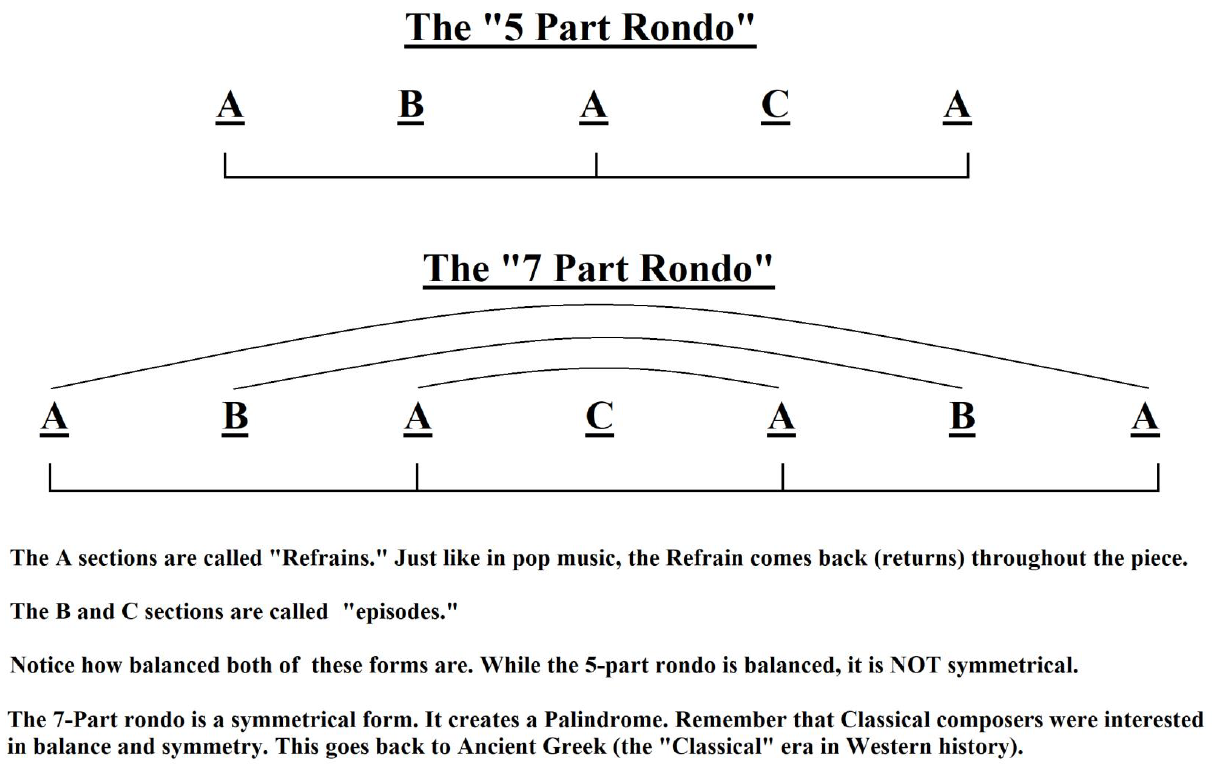4.6.2: Rondo Form- The Fourth Movement of a Symphony or Quartet
- Page ID
- 165594
\( \newcommand{\vecs}[1]{\overset { \scriptstyle \rightharpoonup} {\mathbf{#1}} } \)
\( \newcommand{\vecd}[1]{\overset{-\!-\!\rightharpoonup}{\vphantom{a}\smash {#1}}} \)
\( \newcommand{\id}{\mathrm{id}}\) \( \newcommand{\Span}{\mathrm{span}}\)
( \newcommand{\kernel}{\mathrm{null}\,}\) \( \newcommand{\range}{\mathrm{range}\,}\)
\( \newcommand{\RealPart}{\mathrm{Re}}\) \( \newcommand{\ImaginaryPart}{\mathrm{Im}}\)
\( \newcommand{\Argument}{\mathrm{Arg}}\) \( \newcommand{\norm}[1]{\| #1 \|}\)
\( \newcommand{\inner}[2]{\langle #1, #2 \rangle}\)
\( \newcommand{\Span}{\mathrm{span}}\)
\( \newcommand{\id}{\mathrm{id}}\)
\( \newcommand{\Span}{\mathrm{span}}\)
\( \newcommand{\kernel}{\mathrm{null}\,}\)
\( \newcommand{\range}{\mathrm{range}\,}\)
\( \newcommand{\RealPart}{\mathrm{Re}}\)
\( \newcommand{\ImaginaryPart}{\mathrm{Im}}\)
\( \newcommand{\Argument}{\mathrm{Arg}}\)
\( \newcommand{\norm}[1]{\| #1 \|}\)
\( \newcommand{\inner}[2]{\langle #1, #2 \rangle}\)
\( \newcommand{\Span}{\mathrm{span}}\) \( \newcommand{\AA}{\unicode[.8,0]{x212B}}\)
\( \newcommand{\vectorA}[1]{\vec{#1}} % arrow\)
\( \newcommand{\vectorAt}[1]{\vec{\text{#1}}} % arrow\)
\( \newcommand{\vectorB}[1]{\overset { \scriptstyle \rightharpoonup} {\mathbf{#1}} } \)
\( \newcommand{\vectorC}[1]{\textbf{#1}} \)
\( \newcommand{\vectorD}[1]{\overrightarrow{#1}} \)
\( \newcommand{\vectorDt}[1]{\overrightarrow{\text{#1}}} \)
\( \newcommand{\vectE}[1]{\overset{-\!-\!\rightharpoonup}{\vphantom{a}\smash{\mathbf {#1}}}} \)
\( \newcommand{\vecs}[1]{\overset { \scriptstyle \rightharpoonup} {\mathbf{#1}} } \)
\( \newcommand{\vecd}[1]{\overset{-\!-\!\rightharpoonup}{\vphantom{a}\smash {#1}}} \)
Rondo Form.
Composers would often reserve a rondo form for the 4th movement of their work (if the music only had 3 movements, they would often use it for the 3rd movement). This does not mean that rondos only exist within the 4-movement structure. Some composers wrote rondos as standalone works. Fur Elise is a great example of a standalone piece in rondo form.
Rondos are fairly simple: they consist of repeating refrains that are constantly interrupted by different episodes.
If we were to organize a rondo form using letters, the "A" would be used for the refrain, while "B," "C," and "D," etc. would be used for episodes.
A 5-part rondo is the most common type of rondo we see in the literature. It looks like this: A B A C A
You can see how the "A" sections are interrupted by the "B" and "C" section.
As mentioned above, Beethoven's famous Fur Elise is found in this "ABACA" form. Take a listen to Lang Lang's performance of this famous piano work, and see if you can recognize when the refrain comes back. It's very easy to recognize, because the refrain is very catchy. As you listen, make sure you ask yourself what makes these A, B, and C sections sound different.
For you convenience, here are the time stamps for the different sections:
A: 0:00
B: 0:55
A: 1:23 (you'll hear him set the A up at 1:17, but he takes his time!)
C: 2:20 (this is a much darker and more angry sounding section)
A: 2:47
You'll notice that each section has their own character. The A section is quite somber, the B section is more lively and optimistic, and the C section is much more angry and almost violent. This is common! Different sections in music will likely be in different characters and will be in different keys.
The beauty of the ABACA form is in its balance, which is a characteristic that the Ancient Greeks favored. With an "A" on either sides and the middle, we have a "B" and "C" as the 2nd and 4th sections. Balanced as it may be, it's not symmetrical. This is where we get the 7 part rondo:
The 7-part rondo: ABACABA form (pure symmetry)
As you can see from ABACABA, we have a perfectly symmetrical form. Moreover, it can be arranged into a form that resembles ABA C ABA. This makes it look like we have an ABA (ternary) on either side of a contasting "C" section. Composers enjoy this form because it provides them with the symmetry that isn't found in the 5-part rondo.
The handout below provides a cleary depiction of these two different rondo forms.

The piece you'll look at in the video for rondo is actually in nine parts! It goes by fast, and it's a lot of fun. When you're done, move onto the next page, where you'll read about the Sonata form.

